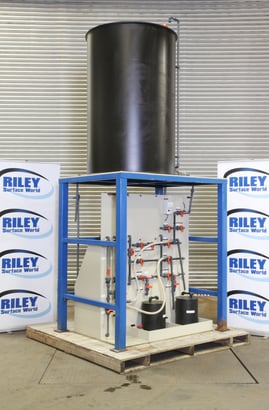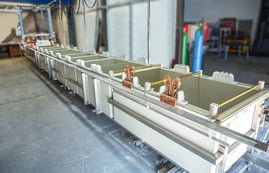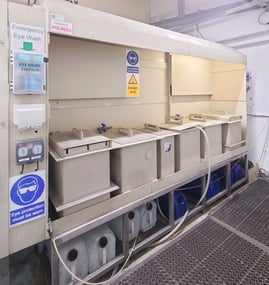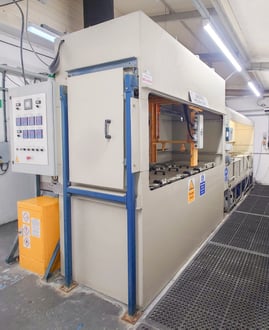Leading Methods of Metal Plating

One of the core types of large plant we sell at Riley Surface World, plating lines come in many shapes and sizes depending on the function of their application and the desired quality of the finish.
For what can be a chemically complex process initially, metal plating can provide a component with a fantastic range of improved and new properties. Continue reading to find out what benefits these include and the method for how it’s achieved.
Benefits of Metal Plating
Metal plating offers a range of significant benefits, enhancing both the functional and aesthetic qualities of industrial & commercial products.
One of the primary advantages is increased durability. Metal plating provides a protective layer that shields the underlying material from corrosion, wear, and environmental damage. This is particularly crucial in industries where equipment and components are exposed to harsh conditions such as aerospace, automotive and marine sectors. For instance, chrome plating on automotive parts not only adds an attractive finish but also ensures longevity by preventing rust and surface deterioration. Additionally, plating can improve hardness and resistance to abrasion, thereby extending the lifespan of machinery and tools.
Another key benefit of metal plating is improved conductivity for electronic applications. Metals like gold, silver, and copper are commonly used for plating electronic components due to their excellent conductive properties. This ensures efficient signal transmission and reduces the risk of electrical failures.
Additional benefits that can be provided from metal plating include:
- Increased chemical, oxidation or thermal resistance
- More aesthetically pleasing or expensive looking appearance
- Improved coating adhesion
- Tarnish prevention
- Reduced friction
- Improved solderability quality
Types of Metal Plating - Electroplating
The most known and widely used metal plating method, electroplating is a process that uses electrical current to deposit a layer of metal onto the surface of the part to be plated (substrate) to enhance its properties. Taking place in an electrolyte solution, two electrodes need to be present. One electrode acts as the cathode (object to be coated) while the other as the anode (material used for plating).
When both are immersed, an electrical current is passed through the solution, resulting in metal ions (that have become positively charged) separating from the anode and being attracted to the negatively charged cathode (component) as a thin, uniform coating. To achieve a thicker coating, multiple applications may be required.
Types of Metal Plating – Electroless Plating
Electroless plating, also known as autocatalytic plating, is a chemical method used to deposit a metal layer on a component without the application of an external electrical current. Once the component is cleaned of any contaminates that could interfere with the coating adhesion (the same pre-process is done in electroplating), the component is immersed in an aqueous reducing agent solution containing a catalyst.
The autocatalytic reaction that takes place causes metal ions from a submerged source of metal to separate and coat the component in an even & uniform layer. Plating the component with more intricacy than electroplating, electroless plating has the ability to coat complex geometrical The longer the component remains in the solution the thicker the layer of metal ions deposited, forming a thicker coating.
This more cost-effective plating option offers platers a wide range of metal plating options. One of the most popular processes is nickel plating, for improving the hardness and resistance to components.
As electroless plating doesn’t require the component to act as an electrode and pass electric current it can be used to coat non-conductive materials. For instance copper, gold and silver can be added onto a components for use in electronics or as a base later for electroplating.
Types of Metal Plating – Immersion Plating
A plating process that applies metal coatings via a method of displacement, immersion plating (also known as replacement plating & dip plating) is a plating process exclusively for applying coats of noble metal such as gold, silver, platinum & rhodium.
Taking place in an electrolyte solution featuring ions of the noble metal, the component is immersed in the solution and undergoes a dissolution reaction. The metal ions on the surface of the component dissolve away and are replaced with the noble metal ions in the solution. When the noble metal ions have coated the entire substrate, the process is complete and will halt.
A common application for immersion plating is coating copper parts with silver.
Metal Plating Equipment for Sale
Having specialised in plating lines for over 55 years, Riley Surface World has always seen the value of plating lines and what they can offer the industry, new or used. Our Direct From Site clearances cater to the large plant frequently seen with these treatment lines, check out our latest events or visit our Electroplating & Treatment Lines range to see what is available for you.
Alternatively, if you have a plating line you're looking to sell, call our Direct From Site team at 01922 749284 or email at [email protected] to get the most value for your set up.
Jacquet Weston Engineering Packaged Demineralisation Water Treatment Plant
Manually operated, the de-mineralisation unit produces up to 200 l/h when connected to a 1,000 litre holding tank. At the estimated hourly production of 45 l/h demineralised water the unit will need regenerating every 75-80 hours.
- Stock No
- MA748
- Category
- Electroplating & treatment lines
- Model
- Jacquet Weston Engineering Ion Exchange Plant
- Work Envelope (WxDxH mm) [?]
- Brake / Storage Tank Ø900 x 1500
- Process Stages
- Single Stage
- Other Info
- Producing up to 200 litres/hour
- Condition
- From a working environment, Good Condition
- Sold As Seen Price [?]
- £ 1,250 (+ VAT)
- Special Price (sold as seen) [?]
- Login or Register for price.
- Special offer ends
- 05 November 2025 15:00 GMT while stocks last
Eagle Engineering and Pioneer Prototype Unused, 14 Stage, Semi-Auto, Rack & Barrel Plating Plant
An Unused, 14 Stage, Polypropylene Barrel Plating Plant with Transporter. Includes two barrels and can be commissioned and adapted by the OEM.
- Stock No
- PIO5701
- Category
- Electroplating & treatment lines
- Model
- Eagle Engineering and Pioneer Prototype Manual
- Year of Manufacture
- 2023
- Work Envelope (WxDxH mm) [?]
- 830 x 580/1235/1480 x 645
- Process Stages
- 14
- Other Info
- Barrels 2 off 385mm wide 300mm Ø
- Condition
- Brand New, Excellent Condition, Unused, Current Model
- Location
- Hereford, UK
- Direct Site Clearance Price [?]
- £ Login or Register for price.
- Part of a Direct Site Clearance
- Unused Rack & Barrel Semi-Automatic Plating Plant
Balco Engineering Ltd Manual Electropolish Line
An ideal opportunity to acquire a manual Electropolishing Line installed by Balco Engineering Limited in 2013 and subject to an upgrade by them in 2016.The line is utilised in the production of medical implants. The plant is fully operational and can currently be viewed working by prospective buyers.
- Stock No
- TEC300
- Category
- Electroplating & treatment lines
- Model
- Balco Engineering Ltd Manual Electropolish
- Year of Manufacture
- 2013
- Work Envelope (WxDxH mm) [?]
- 200/320/360/390 x 500 x 500
- Process Stages
- 6
- Other Info
- Wall mounted control cabinet containing
- Condition
- From a working environment, Seen working by RSW, Good Condition
- Location
- Sheffield, UK
- Direct Site Clearance Price [?]
- £ Login or Register for price.
- Part of a Direct Site Clearance
- Tecomet Medical Industry Vibratory & Electropolishing Finishing Lines
Balco Engineering Ltd Automatic Electropolish Line
An ideal opportunity to acquire an automatic electropolishing line, installed by Balco Engineering Limited in 2016 utilised in the production of medical implants. The plant is fully operational and can currently be viewed working by prospective buyers.
- Stock No
- TEC400
- Category
- Electroplating & treatment lines
- Model
- Balco Engineering Ltd Automatic Electropolish
- Year of Manufacture
- 2016
- Work Envelope (WxDxH mm) [?]
- 260/360 x 500 x 650
- Process Stages
- 6
- Other Info
- Fume Exhaust System (4,386 CFM)
- Condition
- From a working environment, Seen working by RSW, Good Condition
- Location
- Sheffield, UK
- Direct Site Clearance Price [?]
- £ Login or Register for price.
- Part of a Direct Site Clearance
- Tecomet Medical Industry Vibratory & Electropolishing Finishing Lines
Machines & equipment for sale
- Surface Treatment
- Cleaning & Degreasing
- Polishing & Belt Linishing
- Mass Finishing
- Ovens & Furnaces
- Process Cooling
- Shot Blasting
- Dust & Fume Extraction
- Air Compressors
- Rectifiers & Transformers
- Miscellaneous
- Latest Stock
- Special Offers
- Direct From Site Clearances
- Auctions
- Brand New Machines
- Available Immediately
- Sell Your Machine
Machine Alert
Get the latest machines emailed directly to you as they become available to buy online. Sign Up Now







